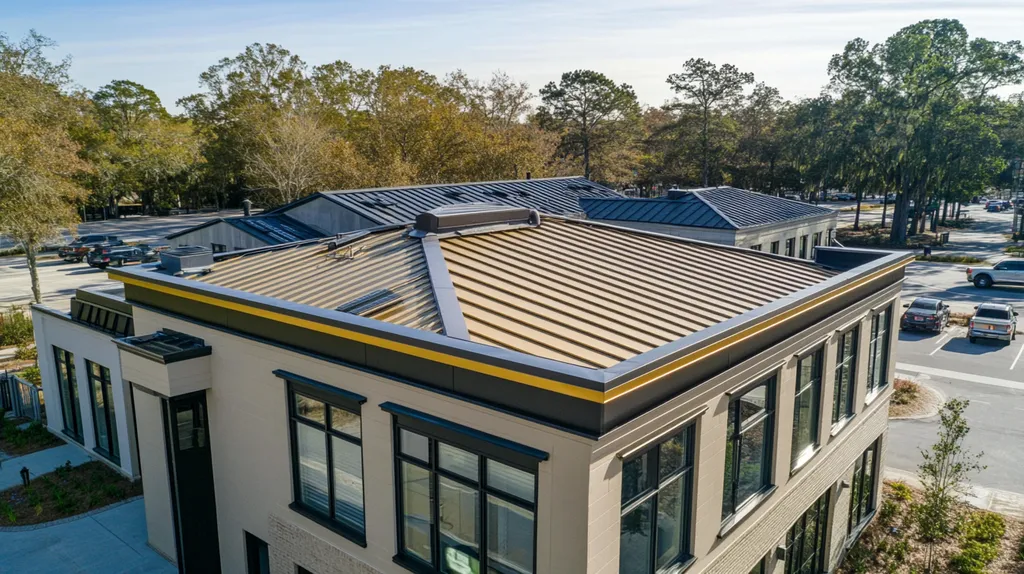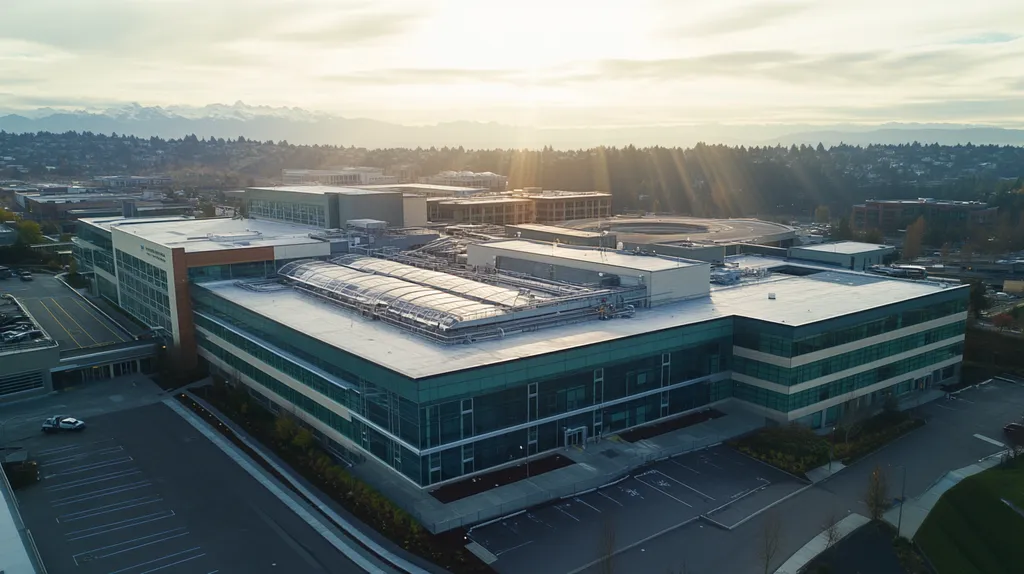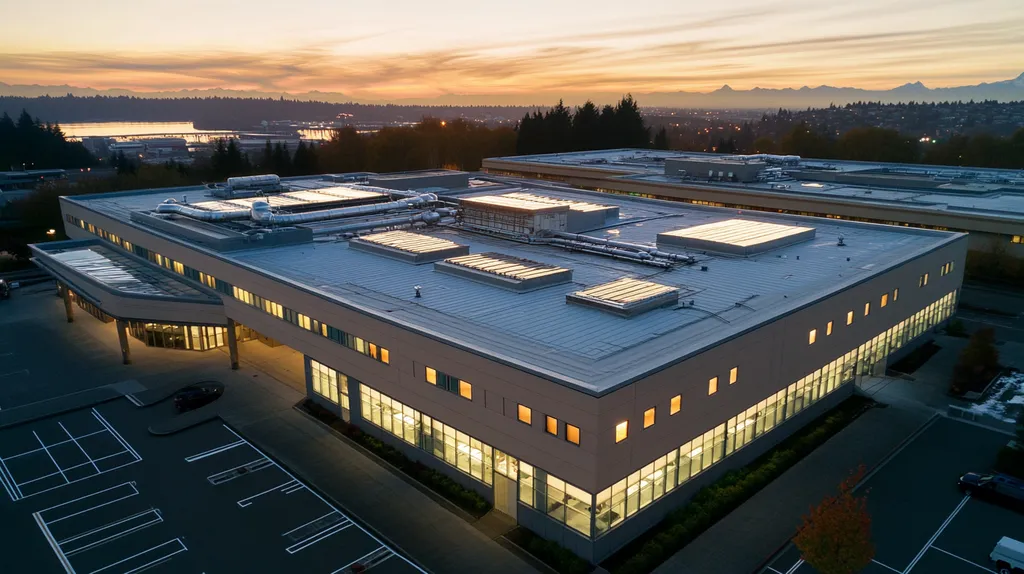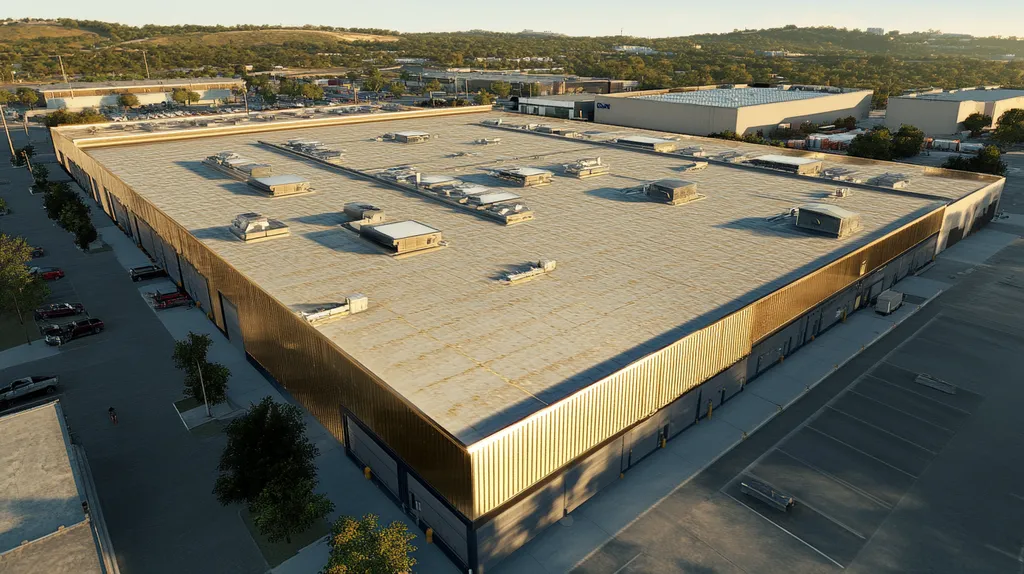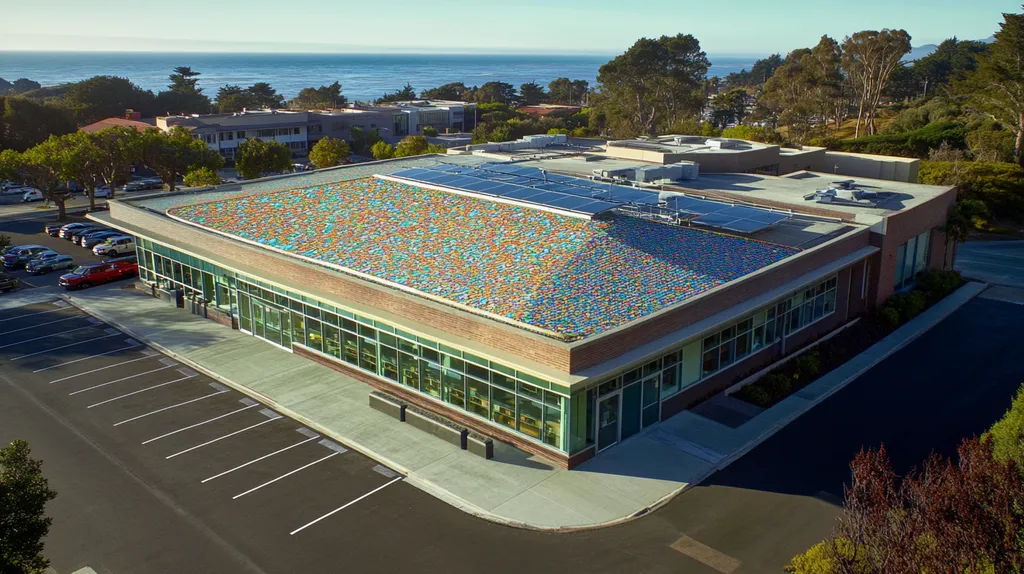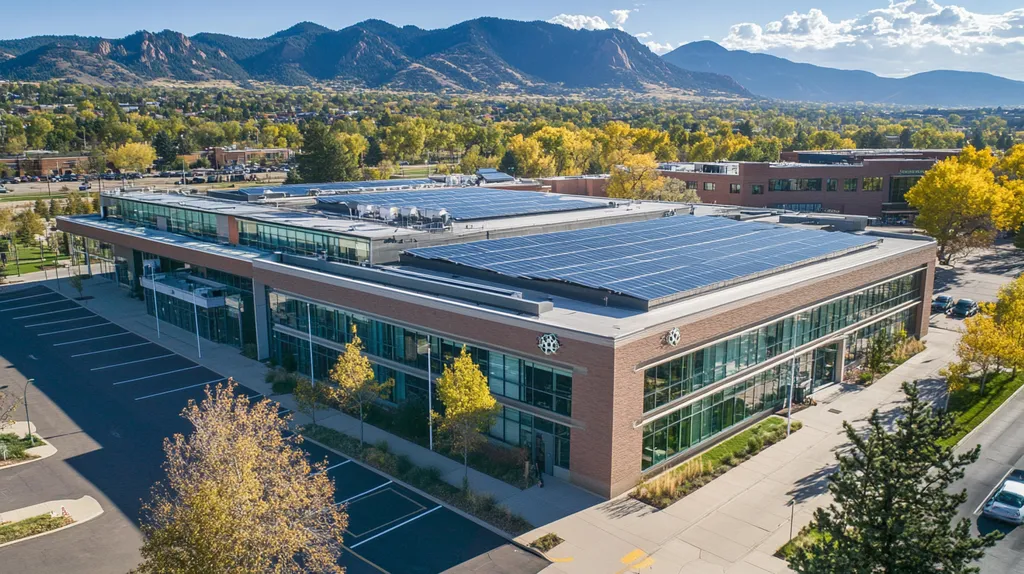Each year, poorly installed rooftop equipment costs industrial facilities millions in repairs, energy waste, and safety violations. Industry data shows that over 40% of commercial roof failures stem from improper equipment installations.
From HVAC systems to solar panels, industrial roofs bear increasingly complex arrays of essential equipment. Without proper installation protocols, these additions can compromise structural integrity and create hazardous conditions.
This comprehensive guide examines the critical risks of unprofessional equipment installation, exploring everything from fundamental load calculations to advanced monitoring systems that protect your facility’s most vital asset – its roof.
SECTION 1: FUNDAMENTAL CONCEPTS
When it comes to equipment installation on industrial roofs, safety and efficiency are paramount. Unfortunately, unprofessional installations can lead to serious problems, including structural failures, safety hazards, and skyrocketing maintenance costs. Recognizing these risks is vital for property owners and facility managers. This section will delve into the key elements of roof structure and load capacity, the various types of equipment commonly installed, and the essential safety and regulatory standards that govern these practices.
Roof Structure and Load Capacity
Grasping the intricacies of a roof’s structure and its load capacity is crucial for safe equipment installation. Each roof is designed to handle certain weights, which include its own weight and any additional loads that might be added later. Exceeding these limits can result in sagging or, in the worst cases, roof collapse, posing severe risks to both the building and its occupants.
For example, flat roofs are often built with lighter materials, making them more susceptible to extra weight. If heavy equipment—like HVAC units or water tanks—is added without a thorough load assessment, the consequences can be catastrophic.
Before any installation, a comprehensive load analysis should be conducted. This evaluation examines the roof’s materials and how weight is distributed across the surface. Even a small adjustment in equipment can lead to significant structural challenges.
Ultimately, understanding how roof structure and load capacity work together can help property owners avoid expensive, unforeseen repairs and enhance overall safety.
Equipment Types and Purposes
Industrial roofs are typically designed to accommodate a diverse array of equipment, each fulfilling essential functions within the building. Common installations include HVAC systems, ventilation units, water tanks, and solar panels, all of which play vital roles in maintaining operational efficiency.
However, the characteristics and requirements of these systems can differ dramatically. For instance, HVAC units can be quite heavy and often need additional structural support to ensure they are safely secured. In contrast, solar panels may weigh less but they still require proper installation to ensure they perform effectively and withstand various weather conditions.
If equipment is improperly installed or guidelines are ignored, the results can range from inefficiencies to complete system failures. For example, an inadequately fastened HVAC unit could become dislodged during high winds, leading to significant damage to the roof and surroundings.
Being aware of the unique characteristics and installation needs of each type of equipment is vital for preventing costly errors. Correct installation not only maximizes the efficiency of the equipment but also ensures the integrity of the roof itself.
Safety and Regulatory Standards
Safety and regulatory standards play a pivotal role in the installation of equipment on industrial roofs. These guidelines are designed to protect both the property and the people working on it from hazards associated with poor installation practices. Ignoring these standards can result in penalties, increased liability, and, most importantly, accidents.
Organizations like the Occupational Safety and Health Administration (OSHA) establish clear requirements for safe equipment installation. These include directives on weight distribution, secure mounting practices, and the necessary safety gear for installers.
Neglecting to adhere to these safety standards can have severe repercussions. Not only do accidents pose risks to injury, but they can also lead to substantial financial losses from lawsuits and insurance claims. Regular safety audits and strict compliance with protocols are crucial to minimizing risks.
Moreover, staying informed about any changes in regulations is essential for property owners and facility managers. Keeping current with these standards not only ensures compliance but also promotes safe and efficient installations, thereby avoiding costly repercussions in the future.
SECTION 2: SYSTEM COMPONENTS
The installation of equipment on industrial roofs carries substantial risks, especially when conducted by untrained individuals. Errors during installation can lead to damaging leaks, safety threats, and decreased energy efficiency. For instance, research shows that improper HVAC installations can increase energy costs by as much as 30%. Understanding the critical components involved in these systems is vital for mitigating these risks and ensuring optimal performance of the roof.
HVAC and Plumbing Systems
Installing HVAC systems is essential for creating a comfortable and efficient indoor environment, yet poor installation can jeopardize a roof’s integrity. If ducts and equipment are not sealed properly, moisture can seep in and cause leaks that compromise the roof structure.
In addition, improper positioning of HVAC units can block drainage systems, resulting in dangerous water pooling that further damages the roof. A subpar HVAC setup not only wastes energy but can also lead to increased utility bills and greater environmental impact.
It is crucial for facility managers to ensure HVAC installations are carried out by qualified professionals who have a solid understanding of roofing systems. Regular follow-up inspections help identify and rectify potential issues before they escalate, preserving system efficiency for years to come.
Investing in proper installation practices ensures HVAC systems operate effectively, protecting both the roof and the well-being of the building’s occupants.
Electrical and Solar Panel Installations
As industrial facilities embrace renewable energy strategies, the installation of electrical systems and solar panels has become increasingly vital. However, unprofessional installations can create serious structural problems. For example, solar panels that are not securely mounted may place extra weight on a roof, putting its structure at risk.
Moreover, improperly executed electrical work can become a fire hazard. Loose wiring connections are prone to overheating or short-circuiting, which can, in the worst-case scenario, result in fires. It’s crucial to hire certified electricians with experience in rooftop installations.
By adhering to best practices, facilities can not only ensure safety but also prolong the lifespan of their electrical systems and roofs. This is essential for minimizing downtime and maintaining operational efficiency.
Investing in certified installations maximizes the benefits of solar energy while ensuring compliance with safety regulations, leading to enhanced performance and reduced long-term costs.
Generators and Backup Power Systems
Generators and backup power systems are vital for industrial operations, especially in areas prone to outages. Yet, poor installation can lead to serious risks, including roof damage and limited access for maintenance. Generators must be firmly secured to prevent movement that might create leaks or lead to excessive wear on roofing materials.
Additionally, improper ventilation can cause harmful exhaust build-up, negatively impacting indoor air quality. Untrained technicians may neglect to evaluate the roof’s load-bearing capacity, leading to structural complications.
It is essential for facility managers to engage licensed professionals who can properly assess and manage these risks. Regular maintenance checks are crucial to ensure that generators and backup systems operate smoothly, without jeopardizing the roof.
Addressing these vulnerabilities by prioritizing quality installation and maintenance can lead to improved reliability for power systems, protecting the entire facility from costly operational interruptions.
SECTION 3: IMPLEMENTATION METHODS
When it comes to installing equipment on industrial roofs, the stakes are high. Improper installation can lead to serious safety risks and financial repercussions, with the National Roofing Contractors Association indicating that nearly 30% of roofing issues stem from unprofessional setups. This section highlights essential placement techniques, crucial support systems, and common pitfalls that can escalate risks. By mastering these implementation methods, property owners and facility managers can protect their roofs and their investments.
Proper Equipment Placement Techniques
Placing equipment correctly on an industrial roof is essential to prevent undue strain and potential damage. Equipment should be kept away from critical areas like drains and vents to avoid water pooling, which can lead to leaks. Conducting a detailed site analysis helps identify load-bearing zones that can safely support the weight of equipment.
Aligning installations with the building’s original design is equally important. This alignment ensures that new installations do not compromise the roof’s structural integrity. By adhering to the specified weight limits for each piece of equipment, the risk of leaks or punctures is significantly reduced.
Additionally, considering local weather conditions is crucial. For example, unsecured equipment can be easily dislodged by strong winds, leading to costly damage. Following guidelines that take into account the local climate helps ensure effective placement and can prevent future expenses.
Ultimately, investing in professional assessments prior to installation allows property owners to make informed choices, safeguarding the roof and its functionalities.
Use of Supports and Access Systems
Support structures and access systems are vital for maintaining equipment stability and ensuring safety. The appropriate use of supports, such as brackets or frames specifically designed for roof applications, helps distribute weight evenly, lowering the risk of roof collapse under heavy loads.
Access systems, including ladders and walkways, facilitate safe movement around equipment, greatly reducing the potential for accidents. Clearly defined pathways and installation zones enable maintenance workers to navigate safely, without risking damage to the roof or themselves.
Incorporating safety features, like guardrails and harness points, ensures compliance with safety regulations while preventing falls. These preventive measures protect not just the workers but also the facility from potential liability issues.
Conducting regular inspections and maintenance checks on both support structures and access systems is crucial for ensuring their ongoing compliance and functionality. This proactive approach can effectively minimize the risk of roof failures in the long run.
Avoiding Common Installation Mistakes
Many problems stem from unprofessional installations, often due to misunderstandings or simple neglect. One typical oversight involves disregarding drainage patterns at the roof perimeter, which can lead to water accumulation and subsequent leaks. Careful planning should include a comprehensive review of the roofing system before any installation begins.
Another frequent error is the inadequate sealing of openings created during equipment installation. Failing to properly seal these penetrations can open the door for moisture infiltration, ultimately causing mold and structural damage over time. Hiring trained professionals to oversee these tasks ensures that all seals are completed effectively.
Moreover, neglecting to adhere to local building codes can have serious financial consequences, including fines and required modifications. Every installation must comply with these regulations to maintain safety standards and avoid unnecessary expenses. Therefore, checking local codes before installation is essential.
Finally, providing ongoing training for installation teams is crucial. Continuous education on best practices fosters a culture of quality and safety, benefiting the roofing system and reducing the likelihood of repeated mistakes.
SECTION 4: MAINTENANCE REQUIREMENTS
Neglecting maintenance on industrial roofs can lead to dire consequences, including costly equipment damage and serious safety hazards. In fact, research indicates that over 30% of roof-related issues arise from inadequate maintenance. To mitigate these risks, property owners and facility managers must prioritize regular inspections, protect against water and chemical damage, and ensure worker safety during maintenance activities. Each of these factors plays a crucial role in extending the life of the roof and safeguarding the assets beneath it.
Regular Inspection Protocols
Implementing a regular inspection schedule is essential for identifying problems before they worsen. Inspections should occur at least twice a year, and immediately after severe weather events. These assessments should be conducted by qualified professionals who will examine both the roof membrane and any installed equipment for signs of wear, damage, or poor installation practices.
Thorough inspections involve checking for leaks, identifying punctures, and evaluating the stability of equipment. Documenting each inspection helps track the roof’s condition over time, enabling timely repairs. Furthermore, property owners should be aware of warranty requirements, as many stipulate regular inspections to maintain validity.
Utilizing advanced technologies like drones can significantly enhance inspection efficiency. Drones provide safe access to hard-to-reach areas and can capture detailed images to identify potential vulnerabilities in the roof.
Ultimately, rooftop inspections are not just a formality; they form the backbone of a proactive maintenance strategy. Regular oversight ensures minor issues are addressed promptly, leading to cost savings and a longer-lasting roof.
Preventing Water and Chemical Damage
Water damage is a leading cause of roofing failures in industrial settings. Installing appropriate drainage systems is critical to preventing ponding water, which can result in leaks and structural damage. Ensuring that drains, gutters, and downspouts are clear of debris is vital for maintaining proper water flow.
Chemical exposure also presents significant risks for roofing systems. Many industrial roofs are subjected to chemicals that can deteriorate roofing materials over time. Understanding the types of chemicals used in a facility is essential for selecting compatible roofing materials that can withstand the exposure.
Routine maintenance should include cleaning and monitoring potential leaks from equipment installations. For instance, roofs that support air conditioning units require regular checks for fluid leaks that could compromise roofing membranes. Addressing these risks proactively helps preserve the structural integrity of the entire facility.
By implementing these preventive measures, property owners can significantly decrease the likelihood of severe damage. This attention to detail not only safeguards investments but also extends the lifespan of roofing systems.
Ensuring Worker Safety During Maintenance
Worker safety must be a top priority during any maintenance activities on industrial roofs. Establishing proper safety protocols, including the use of harnesses, is essential to prevent falls. According to OSHA, falls are the leading cause of fatalities in construction, including roofing.
Training all personnel involved in maintenance is crucial. Workers should be well-versed in safe practices and proper equipment usage to avoid accidents on the rooftop. Regular safety drills can reinforce the importance of these protocols.
Additionally, creating a safety perimeter around maintenance areas protects both workers and the equipment being serviced. Using signage and barriers can alert other employees about ongoing maintenance and help prevent accidents.
Lastly, maintaining clear communication during maintenance tasks fosters a safer working environment. Coordinating efforts between crews on the roof and facility managers ensures all safety protocols are efficiently followed.
SECTION 5: PERFORMANCE METRICS
Monitoring performance metrics is critical for the longevity and security of industrial roofs, particularly after equipment installations. Poor installation practices can not only lead to inefficiencies but also escalate costs over time. For instance, a roof riddled with leaks due to substandard installations can lead to costly downtime and extensive repairs. By mastering how to track and evaluate these metrics, property owners and facility managers can effectively mitigate risks and make informed decisions.
Monitoring Equipment Efficiency
Evaluating efficiency metrics is vital for understanding how well the installed equipment performs. If a system isn’t operating at the level expected, it may signal deeper issues, such as improper placement or the need for better support structures. Ongoing monitoring allows facility managers to catch discrepancies that could stem from inadequate installation practices.
For example, an HVAC unit that lacks proper drainage may cause excess water to accumulate, negatively impacting its efficiency. Keeping track of energy consumption against expected outputs can pinpoint these inefficiencies early on. This proactive monitoring approach can significantly reduce operational costs.
Incorporating data analytics can enhance tracking processes dramatically. With software that captures real-time performance metrics, facility managers can make quick, informed decisions that not only improve equipment efficiency but also extend its lifespan.
Additionally, regular audits reinforce monitoring efforts. Systematic evaluations can reveal potential issues before they escalate, minimizing the risk of severe long-term damage or unexpected shutdowns.
Tracking Maintenance and Repair Costs
Accurately tracking maintenance and repair expenses can reveal a great deal about the condition and performance of installed equipment. Unprofessional installations often lead to unexpected costs due to frequent, necessary repairs. For instance, a cooling unit that is poorly mounted may require repetitive adjustments, increasing ongoing expenses.
By aggregating maintenance costs over time, facility managers can assess the financial burden tied to the initial quality of installations. A noticeable uptick in repair expenses typically signals that installation practices may need reconsideration. These insights can inform budgeting strategies for future repairs or assist in deciding when to invest in replacements.
Keeping detailed repair records aids in accountability as well. This documentation allows property owners the chance to address recurring problems with contractors, fostering better relationships and encouraging improved installation practices moving forward.
Ultimately, meticulous tracking connects performance with expenses, emphasizing the importance of professional installations in achieving long-term savings.
Assessing Roof Integrity Over Time
Regular assessments on roof integrity are essential for grasping the long-term effects of equipment installations. A roof must support various equipment loads, and flawed installation techniques can jeopardize its structure. If a roof becomes compromised, it can lead to leaks and structural failures, underscoring the need for consistent evaluations.
Advanced technologies, such as infrared and moisture scans, can identify potential problems before they become significant. For instance, catching trapped moisture early on can prevent damage that would otherwise involve costly repairs and lengthy downtimes. These technologies serve as early warning systems, prompting proactive measures.
Additionally, maintaining a historical log of roof conditions helps track deterioration trends over time. This information enables facility managers to predict future issues related to improperly installed equipment.
Combining scheduled inspections with technology-driven assessments creates a robust maintenance strategy. This approach reinforces how crucial professional installations are in preserving not only roof integrity but also the overall health of the facility.
SECTION 5: PERFORMANCE METRICS
Monitoring performance metrics is crucial for maintaining the integrity of industrial roofs, especially following equipment installations. If installations are poorly executed, the consequences can include not only inefficiencies but also increasing costs over time. For example, a roof compromised by leaks due to shoddy installations can lead to expensive downtime and extensive repairs. Understanding how to evaluate these metrics empowers property owners and facility managers to mitigate risks effectively.
Monitoring Equipment Efficiency
Efficiency metrics are essential for gauging the performance of installed equipment. If a system operates below expected efficiency, it often signals issues like improper placement or inadequate support structures. Regular monitoring enables stakeholders to identify discrepancies that could stem from poor installation practices.
For instance, an HVAC unit lacking proper drainage can cause excess water to pool, diminishing its operational efficiency. By tracking energy consumption against expected outputs, facility managers can detect these inefficiencies early. This proactive strategy can lead to significant cost savings.
Leveraging data analytics can greatly improve monitoring processes. Utilizing software that captures real-time performance metrics allows facility managers to make swift and informed decisions, enhancing equipment performance and extending its lifespan.
Conducting regular audits complements ongoing monitoring. Systematic evaluations help identify potential issues at an early stage, reducing the risk of long-term damage and unforeseen outages.
Tracking Maintenance and Repair Costs
Accurate tracking of maintenance and repair expenses provides valuable insights into the condition of installed equipment. Unprofessional installations can lead to heightened costs due to frequent repairs. For example, a poorly mounted cooling unit might require constant adjustments, driving up overall expenses.
By compiling maintenance costs over time, facility managers can understand how the quality of initial installations impacts the bottom line. A noticeable uptick in repair costs often indicates that installation practices require reevaluation. This data-driven approach is key for budgeting future repairs or considering replacements.
Thorough documentation of repairs fosters accountability. Keeping meticulous records allows property owners to address recurring issues with contractors, promoting better communication and encouraging improved installation practices.
Ultimately, diligent tracking connects performance outcomes to expenses, underscoring the necessity for professional installations to achieve long-term savings.
Assessing Roof Integrity Over Time
Regular assessments of roof integrity are vital for grasping the long-term effects of equipment installations. Given that roofs must withstand various equipment loads, improper installation techniques can jeopardize structural stability. A compromised roof often leads to leaks and structural failures, highlighting the need for consistent evaluations.
Advanced technologies, like infrared and moisture scans, can identify potential problems prior to escalation. For example, detecting trapped moisture early can prevent significant damage, resulting in substantial cost savings on repairs and downtime. These technologies act as early warning systems, facilitating timely intervention.
Moreover, maintaining a historical log of roof conditions helps track deterioration trends over time. This knowledge allows facility managers to predict future issues related to improperly installed equipment.
Combining scheduled inspections with technology-driven assessments creates a robust maintenance strategy. This comprehensive approach reinforces the critical role of professional installations in preserving roof integrity and ensuring the overall health of the facility.
The Bottom Line
With over 40% of commercial roof failures linked to improper equipment installation, the stakes could not be higher for industrial facility owners and managers.
The financial impact of unprofessional installations extends far beyond immediate repair costs, often resulting in increased energy consumption, shortened equipment lifespan, and potential liability issues.
Professional installation practices, combined with proper monitoring systems and regular maintenance protocols, form the foundation of a secure and efficient industrial roofing system.
By understanding and addressing the risks outlined in this guide, facility managers can protect their investments, ensure worker safety, and maintain optimal building operations for years to come.
The choice between professional and unprofessional installation often determines whether a roof becomes an asset or a liability for an industrial facility.
FREQUENTLY ASKED QUESTIONS
Q. What risks come with unprofessional installations on commercial roofs?
A. Unprofessional installations can lead to structural failures, safety hazards, and expensive repairs. If equipment is placed without proper analysis, it might exceed the roof’s load capacity, increasing the likelihood of leaks and even roof collapse. Understanding these risks is essential for safeguarding your investment and ensuring safety.
Q. How can I prevent leaks in my industrial roof?
A. To prevent leaks, ensure all equipment is installed properly and check seals around penetrations. Regular maintenance, including inspections after severe weather, will help catch potential leaks early. Implementing effective drainage systems is also essential to direct water away from critical areas.
Q. What installation mistakes should I avoid on my industrial roof?
A. Common mistakes include poor placement of equipment, inadequate sealing of openings, and neglecting drainage patterns. These oversights can lead to leaks, water pooling, and even structural damage. Hiring qualified professionals can help ensure adherence to best practices and local codes.
Q. How often should I inspect my industrial roof?
A. It’s recommended to inspect your roof at least twice a year and immediately after severe weather events. Qualified professionals should evaluate the roof and installed equipment for wear or damage, ensuring any minor issues are addressed before they escalate into significant problems.
Q. What are the benefits of professional installation on industrial roofs?
A. Professional installations ensure compliance with safety regulations, enhance equipment efficiency, and protect roof integrity. Certified professionals have the experience needed to properly assess load capacities and install equipment without compromising structural stability, ultimately saving costs on repairs and increasing the lifespan of your roof.
Q. How can weather impact my industrial roof?
A. Weather can severely affect your industrial roof’s integrity. Heavy rain can lead to water accumulation if drainage systems fail. High winds can dislodge improperly secured equipment, while extreme temperatures can cause materials to expand or contract, leading to cracks or leaks if not managed correctly.
Q. What role does drainage play in roof maintenance?
A. Effective drainage is crucial for preventing water pooling, which can lead to leaks and other structural issues. Routine maintenance should ensure that drains, gutters, and downspouts are clear of debris. A well-drained roof not only lasts longer but also minimizes repair costs over time.

